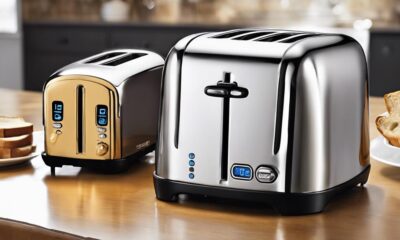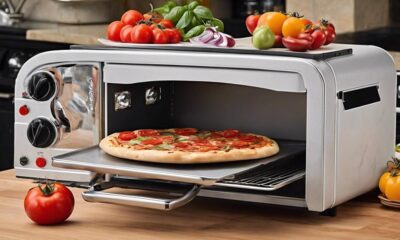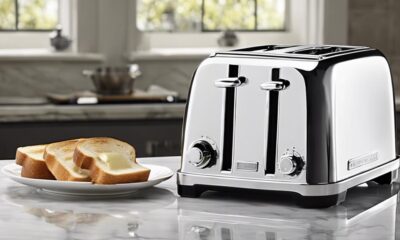Appliances
What Are Solutions to Common Microwave Issues?
2025

Are you in need of troubleshooting your microwave? No worries, we can help! This guide will explore the solutions for common microwave problems you may encounter.
From a microwave that won’t turn on to one that isn’t heating food properly, we’ll address it all. We’ll also tackle problems like sparking or arcing, a plate that won’t rotate, and unusual noises coming from your microwave.
Additionally, we’ll explore solutions for a malfunctioning timer, uneven defrosting, a microwave tripping the circuit breaker, and a non-functional interior light.
By the end, you’ll have the knowledge and confidence to fix these issues like a pro.
Let’s dive in and get your microwave back in top shape!
Key Takeaways
- The most common issues with microwaves include not turning on, not heating food, sparking or arcing, and the plate not rotating.
- Solutions for these issues may include checking for loose electrical connections, replacing faulty components, removing metal objects, cleaning the microwave, and consulting a professional if needed.
- Other common microwave issues include unusual noises, error codes, door not closing properly, buttons not working, strange smells, timer issues, uneven defrosting, and circuit breaker tripping.
- Troubleshooting steps for these issues may involve checking for obstructions, resetting the microwave, contacting customer support, ensuring accurate cooking time, and seeking professional assistance when necessary.
Microwave Not Turning on
One of the most frustrating issues that can occur with a microwave is when it simply won’t turn on. There are two common causes for this problem: a loose electrical connection or a faulty power cord.
A loose electrical connection happens when the wires inside the microwave become disconnected or loose, preventing the flow of electricity to the unit. To fix this issue, you’ll need to examine the electrical connections, ensuring that they’re securely attached. If you find any loose wires, you can tighten them using a screwdriver or pliers.
The second cause, a faulty power cord, can occur if the cord becomes damaged or worn out over time. To check if the power cord is the problem, you should inspect it for any visible signs of damage, such as frayed or exposed wires. If you notice any issues with the power cord, it will need to be replaced. You can purchase a new power cord from an appliance store or contact the manufacturer for a replacement.
Microwave Not Heating Food
Our microwave isn’t warming up the food properly. When your microwave isn’t heating food evenly, it can be frustrating and inconvenient. However, troubleshooting microwave heating issues can help you identify and resolve the problem.
Here are three possible causes and solutions to consider:
- Uneven distribution: If your microwave isn’t heating food evenly, it could be due to improper placement or overcrowding. Make sure that you arrange the food in a single layer and leave space between the items for proper airflow. Stirring or rotating the food during heating can also help achieve more even heating.
- Incorrect power settings: Check if the microwave is set to the correct power level. If the power level is too low, it may not generate enough heat to warm the food adequately. Adjust the power settings accordingly, and test the microwave with different power levels to see if the heating improves.
- Malfunctioning magnetron: The magnetron is the component responsible for generating the microwave’s heat. If it’s faulty, the microwave may not heat the food properly. In this case, it’s best to contact a professional technician to diagnose and repair the issue.
By considering these troubleshooting steps, you can address the issue of your microwave not heating food evenly. However, if none of these solutions resolve the problem, it may be necessary to seek professional assistance to ensure the safe and efficient operation of your microwave.
Now, let’s move on to the next section about microwave sparking or arcing.
Microwave Sparking or Arcing
Sometimes, microwaves may experience sparking or arcing, which can be a cause for concern. Microwave sparking or arcing occurs when electrical currents jump between metal surfaces inside the microwave. This can happen if there’s a metal object, such as aluminum foil, utensils, or even a metal rack, inside the microwave while it’s in operation.
To prevent sparking or arcing from happening again, it’s important to ensure that the microwave is free from any metal objects before using it. Additionally, it’s crucial to clean the microwave properly to avoid any buildup of food particles or grease, which can also cause sparking or arcing.
To clean the microwave, start by unplugging it and removing the turntable and any other removable parts. Use a mild dish soap or microwave cleaner and a non-abrasive sponge or cloth to wipe down the interior surfaces. Pay special attention to the areas where food tends to splatter, such as the walls, ceiling, and door. Rinse and dry all the parts thoroughly before reassembling them.
Microwave Plate Not Rotating
To troubleshoot a microwave plate not rotating, we can start by checking the rotating mechanism. There are several possible causes for this issue, and here are some troubleshooting solutions and repair options to consider:
- Check the rotating mechanism: Ensure that the rotating mechanism isn’t obstructed or jammed. Remove the plate and inspect the rotating ring and motor to see if there are any visible signs of damage or blockage.
- Test the motor: Use a multimeter to check if the motor is receiving power. If it’s not, there may be a problem with the motor or the wiring. In this case, you may need to replace the motor or repair the wiring.
- Replace the turntable coupler: The turntable coupler connects the motor to the rotating ring. If it’s worn out or broken, it may cause the plate not to rotate. Replace the coupler if necessary.
If these troubleshooting solutions don’t resolve the issue, it may be best to consult a professional technician or contact the manufacturer for further assistance. They can provide more advanced repair options or guide you through the process of fixing the microwave plate not rotating problem.
Microwave Making Unusual Noises
After checking the rotating mechanism, we can now address another common microwave issue – the microwave making unusual noises.
When a microwave starts making unusual noises, it’s important to identify the source of the problem in order to rectify it.
One possible cause of the noise could be issues with the microwave turntable. If the turntable isn’t properly aligned or if there are any obstructions preventing it from rotating smoothly, it can create unusual noises. To fix this, ensure that the turntable is properly placed on the support and that it isn’t obstructed by any objects.
Another potential cause of the noise could be microwave door alignment problems. If the door is misaligned or doesn’t close properly, it can result in vibrations and rattling noises. In this case, check the hinges, latch, and seals to ensure they’re in good condition and properly aligned. Adjusting or replacing any faulty components should resolve the issue.
Microwave Displaying Error Codes
When your microwave starts displaying error codes, it can be frustrating and confusing. However, there are a few troubleshooting steps you can take to try and resolve the issue.
First, consult the user manual or the manufacturer’s website for information on what the error code means and how to address it.
If that doesn’t work, you can try resetting the microwave by unplugging it for a few minutes and then plugging it back in.
If the error code persists, it’s best to call customer support for further assistance.
Troubleshooting Error Code
We can troubleshoot microwave error codes by referring to the user manual for specific solutions. When encountering an error code on your microwave display, follow these steps to troubleshoot the issue:
- Check the user manual: Look for the error code in the user manual and follow the recommended solutions provided by the manufacturer.
- Power issues: Ensure that the microwave is properly plugged in and the power supply is working. Power fluctuations or a tripped circuit breaker can cause error codes to appear.
- Resetting error code: Try resetting the microwave by unplugging it from the power source for a few minutes, then plugging it back in. This can help clear temporary error codes.
By following these troubleshooting steps, you can often resolve error codes on your microwave. If the issue persists, it may be necessary to contact customer support for further assistance.
Now, let’s move on to the next section about resetting the microwave.
Resetting the Microwave
To resolve microwave error codes, we frequently reset the appliance by unplugging it for a few minutes and then plugging it back in. Resetting the power can help troubleshoot issues with error codes on the microwave display.
When error codes appear, it indicates a problem with the microwave’s internal systems. By disconnecting the power, we allow the microwave to reset itself and clear any temporary glitches that may have caused the error.
This process is simple and can often resolve common issues without the need for further troubleshooting or repairs.
However, if the error codes persist after resetting the power, it may indicate a more significant problem that requires professional assistance. In such cases, it’s recommended to contact the manufacturer or a qualified technician for further assistance.
Calling Customer Support
For resolving issues with microwave error codes, our next step is to call customer support. When troubleshooting error codes, it’s important to reach out to the manufacturer’s customer support team for assistance. They have the expertise and knowledge to guide us through the process of diagnosing and resolving the error code.
Here are three key steps to take when calling customer support:
- Provide the error code: When contacting customer support, make sure to provide them with the specific error code displayed on the microwave. This will help them identify the problem more accurately.
- Follow their instructions: Customer support will guide us through the troubleshooting process. It’s important to carefully follow their instructions and perform any necessary steps, such as resetting the microwave or performing diagnostic tests.
- Ask for further assistance: If the issue persists or if we’re unsure about any steps, it’s essential to ask for further assistance. The customer support team will be able to provide additional guidance or arrange for a technician to inspect the microwave if needed.
By following these steps and contacting customer support, we can effectively troubleshoot error codes and resolve any issues with our microwave.
Now, let’s move on to discussing another common microwave issue: the door not closing properly.
Microwave Door Not Closing Properly
We’ve encountered a common issue with microwaves where the door doesn’t close properly. This can be caused by a loose door latch or a broken hinge mechanism.
When the door latch is loose, it fails to engage properly, preventing the door from closing securely.
Similarly, if the hinge mechanism is broken or damaged, the door may not align correctly and won’t close tightly.
Loose Door Latch
The loose door latch on a microwave can prevent it from closing properly. To address this issue, there are a few solutions you can try:
- Adjusting the latch mechanism: Sometimes, the latch may not be aligned properly. To fix this, you can try adjusting the latch mechanism. Refer to the microwave’s user manual for instructions on how to access and adjust the latch mechanism.
- Lubricating the latch mechanism: If the latch is sticking or not moving smoothly, applying some lubricant can help. Use a food-safe lubricant and carefully apply it to the latch mechanism, following the manufacturer’s instructions.
- Tightening the latch screws: Over time, the screws that hold the latch in place may become loose. Check the screws and tighten them if necessary. Be careful not to overtighten, as it may affect the door’s closing mechanism.
Broken Hinge Mechanism
One possible solution for a broken hinge mechanism causing a microwave door to not close properly is to check and adjust the hinge tension. If the hinge tension is too loose, the door may not close securely. To adjust the hinge tension, locate the hinge screws on the side of the microwave and use a screwdriver to tighten them. Start by turning the screws clockwise to increase the tension. Test the door after each adjustment until it closes properly.
If adjusting the hinge tension doesn’t resolve the issue, the next step is to consider replacing the broken hinge. To do this, you’ll need to remove the old hinge and install a new one. Refer to the microwave’s user manual or consult a professional technician for guidance on the specific replacement process.
Microwave Buttons Not Working
When microwave buttons aren’t functioning, troubleshooting is necessary to identify and resolve the issue. Here are some steps to help you troubleshoot button issues:
- Check for power supply: Ensure that the microwave is properly plugged in and receiving power. If the power supply is interrupted, the buttons may not respond.
- Reset the microwave: Sometimes, a simple reset can fix button malfunctions. Unplug the microwave from the power source, wait for a few minutes, and then plug it back in. This can help reset the internal circuitry and resolve any temporary issues.
- Clean the control panel: Over time, dirt, grease, or food particles can accumulate on the control panel, affecting the buttons’ responsiveness. Use a soft cloth dampened with a mild cleaning solution to gently clean the panel. Avoid using harsh chemicals or abrasive materials that may damage the surface.
If these troubleshooting steps don’t resolve the issue, it’s recommended to contact a professional technician for further assistance.
Now, let’s move on to the next section about ‘microwave emitting strange smells’ to address another common microwave issue.
Microwave Emitting Strange Smells
To address the issue of microwave emitting strange smells, we can investigate the possible causes and solutions. Strange smell sources in a microwave can include food spills, burnt food particles, and malfunctioning components. One common cause is food spills that haven’t been cleaned properly. When food spills occur, they can accumulate over time and produce unpleasant odors when the microwave is in use.
Burnt food particles, especially on the interior surfaces or the turntable, can also emit strange smells. These particles can be the result of overheating or cooking food for too long. Lastly, malfunctioning components, such as the fan or heating element, can generate unusual odors.
To eliminate these unusual odors, it’s important to keep the microwave clean. Regularly wipe down the interior surfaces with a damp cloth and mild detergent to remove any food spills or burnt particles. The turntable should also be cleaned thoroughly.
In addition, inspect the microwave’s components for any signs of damage or malfunction. If any issues are detected, it’s recommended to contact a professional technician for repair or replacement. By addressing these potential causes and taking appropriate actions, you can eliminate strange smells and ensure your microwave functions properly.
Microwave Timer Not Functioning Correctly
We have encountered a common issue where the microwave timer doesn’t function correctly. This can be frustrating when you rely on the timer to accurately cook your food. If you’re experiencing this problem, there are a few troubleshooting steps you can take to resolve the issue:
- Check for any physical obstructions: Sometimes, the microwave timer can get stuck if there’s something blocking its path. Make sure there are no objects or debris interfering with the timer’s mechanism.
- Reset the microwave: Resetting the microwave can often fix minor software glitches that may be causing the timer to malfunction. Unplug the microwave from the power source for a few minutes, then plug it back in and see if the timer starts working properly.
- Contact customer support: If the above steps don’t resolve the issue, it may be a more complex problem that requires professional assistance. Contact the manufacturer’s customer support for further guidance and to explore potential repair options.
By troubleshooting the microwave timer, you can ensure that it functions correctly and accurately keeps track of your cooking time.
However, if your microwave isn’t defrosting food evenly, there may be another issue to address.
Microwave Not Defrosting Food Evenly
When your microwave fails to defrost food evenly, there could be several causes. Uneven heating can occur if the food isn’t properly positioned or if the power level is set too high.
To ensure even defrosting, consider using the defrost function on your microwave or using the manual defrost option with lower power settings.
If the issue persists, it may indicate a malfunction in your microwave that requires professional attention.
Uneven Heating Causes
The uneven heating causes of a microwave not defrosting food evenly can be frustrating. To troubleshoot this issue, consider the following:
- Improper placement: Ensure that the food is placed in the center of the microwave, as this allows for more even distribution of the microwaves.
- Uneven power levels: Check if the microwave’s power levels are set correctly. Uneven heating can occur if the power is too high or too low.
- Inadequate time: Make sure to defrost food for the recommended time. Insufficient time can result in uneven heating.
Defrosting Options for Evenness
To address the issue of uneven defrosting in your microwave, we can explore different options for achieving evenness. One approach is to rotate the food during the defrosting process. By turning the food halfway through the defrosting time, you can ensure that all parts of the item are exposed to the microwave’s heat evenly.
Another option is to use the microwave’s power settings effectively. Lowering the power level can help prevent the outer edges of the food from cooking while the center remains frozen.
Additionally, it’s important to follow some defrosting tips, such as arranging the food in a single layer, using microwave-safe containers, and covering the food with a microwave-safe lid or plastic wrap to retain moisture. By implementing these strategies, you can improve the evenness of defrosting in your microwave.
Now, let’s move on to potential microwave malfunctions.

Potential Microwave Malfunctions?
One possible reason for microwave not defrosting food evenly could be a malfunction in the rotating plate mechanism. This mechanism is responsible for rotating the food during the defrosting process, ensuring that all parts of the food are exposed to the microwave radiation evenly. When this mechanism malfunctions, certain parts of the food may not receive adequate heat, resulting in uneven defrosting.
Here are a few troubleshooting tips to address this issue:
- Check if the rotating plate is properly aligned and not obstructed by any objects.
- Ensure that the rotating plate is securely attached to the turntable motor.
- Clean the rotating plate and the turntable motor to remove any dirt or debris that may hinder its movement.
By following these troubleshooting tips, you can address common causes of microwave not defrosting food evenly.
Now, let’s move on to the next section about microwave tripping the circuit breaker.
Microwave Tripping the Circuit Breaker
When our microwave trips the circuit breaker, we can resolve the issue by checking the power cord and outlet for any damage or loose connections. It’s important to ensure that the power cord is securely plugged into the outlet and that there are no frayed wires or exposed conductors. If any damage is found, the power cord should be replaced immediately to prevent electrical hazards. Additionally, it’s crucial to make sure that the outlet is functioning properly and is able to handle the power requirements of the microwave.
To further understand the potential causes of a microwave tripping the circuit breaker, refer to the table below:
| Possible Causes | Solutions |
|---|---|
| Overloaded circuit | Unplug other devices from the same circuit or use a different outlet. |
| Faulty microwave | Have a professional technician inspect and repair the microwave. |
| Circuit breaker malfunction | Consult an electrician to check and replace the faulty circuit breaker. |
| Power surge | Install a surge protector to prevent power spikes. |
| Wiring issues | Contact a qualified electrician to inspect and repair the wiring. |
Microwave Interior Light Not Working
We have encountered a common issue with microwaves, where the interior light isn’t working. This can be frustrating, as the interior light allows you to monitor the progress of your food while it’s being cooked. There are a few possible causes for this problem, and here are some solutions to consider:
- Check for a flickering light: If your microwave’s interior light is flickering, it may be due to a loose connection or a faulty bulb. Make sure to turn off and unplug the microwave before attempting any repairs. You can try tightening the bulb or replacing it with a new one.
- Replace the light bulb: Over time, the interior light bulb in your microwave may burn out. To replace it, consult your microwave’s user manual for instructions on accessing the bulb. Make sure to use a bulb with the correct wattage and size for your specific microwave model.
- Seek professional help: If you’re unable to fix the interior light issue on your own, it’s recommended to seek professional assistance. A qualified technician will have the knowledge and tools to diagnose and repair any underlying electrical problems that may be causing the light to malfunction.
Frequently Asked Questions
How Do I Clean the Inside of My Microwave?
To clean the inside of our microwave, we follow a few simple steps.
First, we mix a solution of equal parts water and vinegar in a microwave-safe bowl.
Then, we place the bowl in the microwave and heat it on high for five minutes. This creates steam that loosens stubborn stains.
Afterward, we carefully remove the bowl and wipe down the interior with a damp cloth or sponge.
This method is effective for regular microwave maintenance.
Can I Use Metal Containers or Utensils in the Microwave?
Using metal containers or utensils in the microwave can be dangerous. Metal can cause sparks and even start a fire due to the intense heat generated by the microwave.
To ensure safety, it’s important to only use microwave-safe containers and utensils made from materials like glass, ceramic, or microwave-safe plastics.
Following these microwave cooking tips will help prevent accidents and ensure your food is heated safely and efficiently.
Why Is My Microwave Making a Buzzing Noise Even When It’s Not in Use?
When a microwave makes a buzzing noise even when it’s not in use, it could be due to a variety of issues.

Our team has extensive knowledge in microwave maintenance and troubleshooting microwave noise.
We recommend checking the turntable and ensuring it’s properly aligned.
Additionally, inspect the cooling fan to see if it’s obstructed.
If the problem persists, it may be necessary to contact a professional technician for further assistance.
How Often Should I Replace the Microwave’s Charcoal Filter?
When it comes to microwave filter maintenance, it’s important to know how often to replace the charcoal filter. Regular replacement ensures optimal performance and keeps your food tasting its best.
The frequency of replacement depends on factors such as usage and the type of cooking done in the microwave. A general guideline is to replace the charcoal filter every 6 to 12 months.
However, for heavy usage or if you frequently cook with strong odors, it may be necessary to replace it more frequently.
What Should I Do if My Microwave Starts Smoking?
If your microwave starts smoking, it’s important to take immediate action to prevent any further damage or potential hazards.
First, turn off and unplug the microwave.
Next, check for any visible signs of burning or damage inside the microwave. If you notice any, don’t attempt to use the microwave and contact a professional for repairs.
If there are no visible signs of damage, it’s recommended to perform a thorough microwave maintenance and troubleshooting to identify and resolve any underlying issues.
What Are the Most Common Microwave Issues and How Can I Fix Them?
Some common solutions for microwave issues include the microwave not heating properly, sparks inside the microwave, and the turntable not turning. To fix these issues, you can try checking the power supply, cleaning the interior, and replacing the turntable motor. Always unplug the microwave before attempting any repairs.
Conclusion
In conclusion, the microwave is like a trusty companion in the kitchen, but it can sometimes face issues that hinder its performance.

By following the solutions provided in this article, you can troubleshoot common problems such as the microwave not turning on, heating food, or rotating the plate.
Additionally, you can address issues like sparking, unusual noises, timer malfunction, uneven defrosting, tripping circuit breakers, and non-functioning interior lights.
With these solutions, your microwave will continue to be a reliable ally in your culinary adventures.
Jules stands at the intersection of appliances and smart home technology, an area that’s rapidly gaining importance in modern homes. With a background in home technology integration, Jules specializes in how traditional appliances can work seamlessly with smart home systems to create more efficient, convenient, and tailored home environments. Jules’s articles provide a glimpse into the future of home living, offering advice on integrating smart technology into every aspect of your home life.
Appliances
Top Appliance Repair Tips Every Homeowner Should Know
With essential appliance repair tips at your fingertips, discover how to prevent costly breakdowns and keep your home running efficiently. Are you ready to learn more?
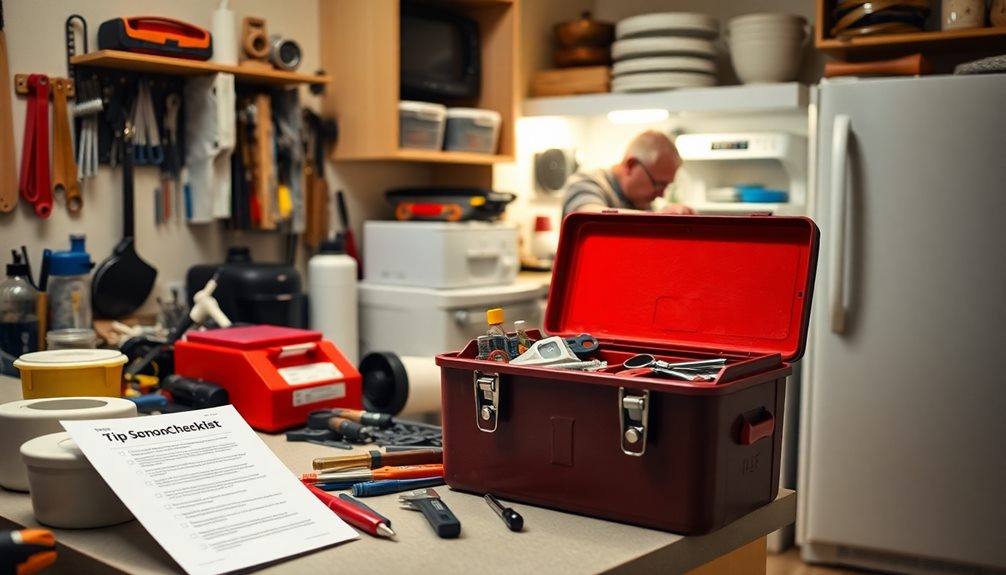
To keep your appliances running smoothly, start by checking the user manual for troubleshooting tips and maintenance guidelines. Always disconnect the power before any repair to avoid electric shock and wear gloves for safety. Regularly clean your appliances; for instance, vacuum refrigerator coils yearly and empty the dryer lint trap after each use. If you notice persistent issues like strange noises or poor performance, don't hesitate to consult a professional. Remember, knowing when to call in an expert can save you time and money. There's a lot more you can learn to enhance your appliance care strategy.
Key Takeaways
- Always disconnect the power supply before starting repairs to avoid electric shock and ensure safety.
- Regularly clean appliance components, like refrigerator coils and dishwasher filters, to maintain efficiency and prevent breakdowns.
- Document recurring issues to provide clear information to professionals when seeking help with complex repairs.
- Use user manuals to understand safety precautions, maintenance tips, and warranty requirements to protect your investments.
- Call a professional for complicated repairs involving gas or electrical systems to ensure proper handling and compliance with safety standards.
Importance of User Manuals
Have you ever wondered how you could save time and money on appliance repairs? One of the simplest ways is by utilizing user manuals. These manuals are important resources that help you troubleshoot common appliance issues without needing a professional. By referring to them, you can quickly identify and resolve problems, which often prevents costly service calls.
User manuals also outline essential safety precautions and potential hazards, guaranteeing you use your appliances safely. They include detailed maintenance recommendations that are significant for extending the lifespan and efficiency of your appliances. Regularly following these guidelines can help keep your appliances running smoothly.
Don't overlook warranty details, either. Understanding the terms in your manual is important to avoid voiding your coverage due to misuse or failure to adhere to manufacturer guidelines.
Moreover, user manuals can help you maximize the features and cycles of each appliance, enhancing their overall performance and your satisfaction. By making it a habit to consult your user manual, you'll not only save time and money but also guarantee your appliances perform at their best.
Safety Precautions for Repairs

When tackling appliance repairs, prioritizing safety is vital. Safety should always come first, so start by disconnecting the power supply to the appliance before you begin any repairs. This helps prevent electric shock or injury.
Don't forget to wear personal protective equipment (PPE), like gloves and safety goggles, to guard against potential hazards during your work. Additionally, if you have appliances like air purifiers, remember to maintain air quality by confirming they're in good working condition while performing repairs.
If you're dealing with gas appliances, make sure to check for gas leaks and verify the gas supply is turned off to avoid dangerous situations. It's also important to use proper lifting techniques when handling heavy appliances to prevent injury.
Always consult user manuals for specific safety guidelines related to your appliance. For complex repairs involving electrical or gas components, it's wise to seek professional assistance. This not only safeguards your safety but also guarantees compliance with regulations.
Troubleshooting Common Issues

Troubleshooting common appliance issues can save you time and money. Start by checking the power source; verify connections, inspect power cords for damage, and reset circuit breakers if necessary.
If you're facing water-related issues, check supply hoses for leaks and inspect internal components like pumps. Also, monitor the water pressure to ascertain everything's functioning properly.
When using ovens or stoves, consider using an oven thermometer to guarantee accurate temperature settings. Inspect gas burners for obstructions or malfunctions, as these can cause uneven cooking.
If you hear unusual noises during operation, check for foreign objects inside, inspect internal components, and verify the appliance is level to minimize noise.
As you troubleshoot, document recurring issues such as low water flow or strange sounds. This information can be invaluable when seeking professional help.
Cleaning and Maintenance Tips

Keeping your appliances clean is essential for their longevity and performance. Regular cleaning not only enhances efficiency but also helps prevent damage and costly appliance repairs. Here are some key maintenance tips to keep your appliances running smoothly:
| Appliance | Maintenance Tip |
|---|---|
| Refrigerator | Clean the coils at least once a year |
| Dishwasher | Check and clean the filter every six months |
| Dryer | Empty the lint trap after every load |
| Oven | Use the self-cleaning mode every six months |
| Dishwasher Spray Arm | Inspect and clean regularly to prevent clogs |
When to Call a Professional

Regular maintenance can help prevent many common appliance issues, but some problems require professional expertise. If you encounter complex issues involving gas or electrical components, it's vital to call a professional. These tasks often necessitate specialized tools and knowledge to guarantee safety and compliance with local regulations.
Additionally, having a home security system can provide peace of mind, knowing your home is protected while you focus on other tasks, including appliance maintenance. Studies show that homes without security systems are considerably more vulnerable to various risks, including theft, which can complicate your appliance repair situation if you're not careful about home safety the effectiveness of home security systems.
Pay attention to persistent problems, like recurring low water flow or strange noises. Ignoring these signs can lead to further damage and increased costs, making it important to seek repair services promptly.
Additionally, if your appliance is still under warranty, a certified technician should handle repairs to avoid voiding any coverage provided by the manufacturer.
For appliances equipped with built-in sensors or smart technology, professional help is typically necessary. Diagnosing and fixing these advanced systems can be complicated, and attempting to do so yourself may result in more issues.
If you ever feel uncertain about performing a repair or lack the necessary tools, don't hesitate to engage a professional. This not only saves you time but also guarantees the job is done correctly and safely, helping you avoid damaging your appliance further.
Frequently Asked Questions
How Can I Extend the Life of My Appliances?
To extend your appliances' life, you should clean them regularly, avoid overloading, and follow the manufacturer's guidelines. Don't ignore small issues; addressing them early can prevent bigger problems down the line. Maintain your appliances consistently!
What Are Common Signs of Appliance Wear and Tear?
You'll notice common signs of appliance wear and tear like unusual noises, inconsistent performance, leaks, or visible rust. If you pay attention to these issues early, you can prevent bigger problems down the line.
Can I Use Generic Parts for Repairs?
Can you really trust generic parts for repairs? While they might save you money, the risk of compatibility issues could lead to bigger problems. Always weigh your options carefully before making that choice. You've got this!
How Often Should I Perform Appliance Maintenance?
You should perform appliance maintenance every six months. Regular checks help catch issues early and extend your appliances' lifespan. Don't wait until something breaks; proactive care saves you time, money, and frustration in the long run.
Are There Eco-Friendly Cleaning Products for Appliances?
You can channel your inner eco-warrior by choosing vinegar, baking soda, or lemon juice for cleaning appliances. These natural products tackle grime effectively, keeping your home fresh while protecting the planet. It's a win-win!
Conclusion
In the world of home appliances, a little knowledge can go a long way. By following these tips, you can tackle minor repairs and keep your appliances running smoothly. Remember, being proactive is like having a trusty toolkit at your fingertips—always ready for action. But don't hesitate to call in the pros when things get tricky. Your home deserves the best care, and knowing when to seek help is just as important as your DIY skills.
Claire is our in-house smart home guru. With a visionary background in electrical engineering and a professional history dotted with stints at leading tech companies, Claire has an unparalleled understanding of smart home technology. She has a talent for demystifying complex concepts, making them accessible to everyone, from tech novices to enthusiasts. Whether it’s the latest in home automation or the newest intelligent kitchen gadget, Claire’s insights help you confidently navigate the smart home landscape.
Appliances
Need a Sears Technician? Here’s How to Find One Fast!
How to quickly locate a Sears technician for your appliance repairs and discover the benefits of their exceptional services waiting for you!
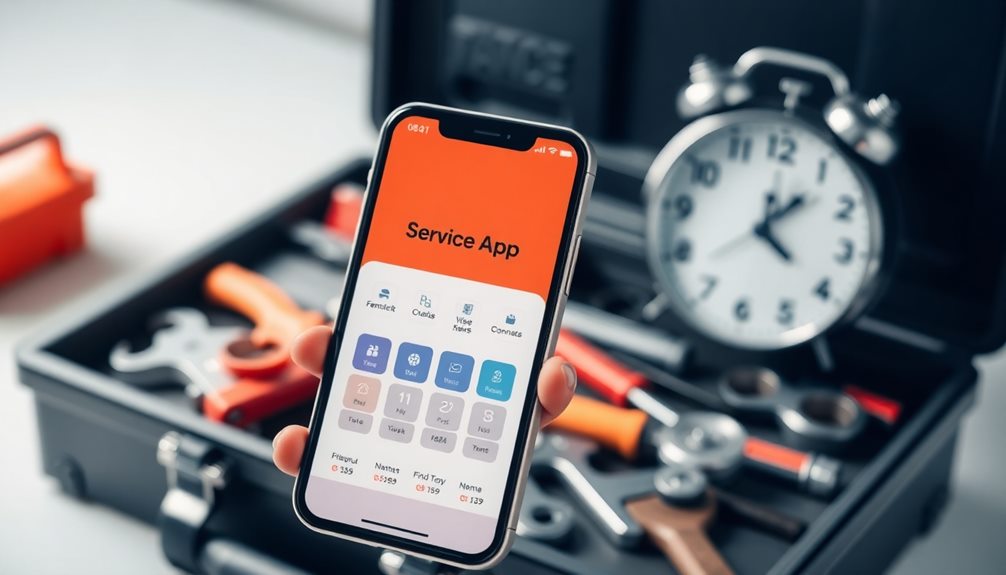
If you need a Sears technician fast, you're in luck! You can schedule service online or via phone/text, with flexible appointments available six days a week. Many areas offer same-day service, minimizing downtime. With over 2,500 experienced technicians, you're guaranteed exceptional repair for appliances like refrigerators and ovens. Most issues get resolved on the first visit, thanks to well-stocked service vans. Plus, Sears boasts high customer satisfaction, with millions of repairs performed annually. So, whether you're facing appliance troubles or just want preventive maintenance, there's a convenient solution ready for you. There's so much more to uncover about their services!
Key Takeaways
- Schedule an appointment online or via phone/text for rapid service availability.
- Enjoy flexible appointment options with same-day service in many areas.
- Benefit from high response rates from technicians, ensuring timely assistance.
- Access over 2,500 experienced technicians ready to address various appliance issues.
- Utilize convenient scheduling to minimize appliance downtime and disruption.
Hassle-Free Scheduling Process
Scheduling a Sears technician is a breeze, thanks to their hassle-free process. You can easily find an appliance repair service that fits your needs. With flexible appointments available six days a week, you're sure to find a time that works for you. Just choose a slot that suits your schedule, and you'll be on your way to getting your appliance fixed.
When a certified professional arrives at your home, they'll diagnose the issue and provide you with price estimates upfront. This transparency allows you to make informed decisions about your repairs without any surprises.
Sears prioritizes minimizing downtime, so you can often expect repairs to be completed during the first visit. This efficiency not only saves you time but also enhances customer satisfaction.
You'll appreciate knowing that the technicians dispatched are experienced and equipped to handle a variety of appliance issues. Their commitment to quality and quick service means you can get back to your routine without prolonged interruptions.
Services Offered by Sears

When you choose Sears for your appliance repair needs, you gain access to a wide range of services designed to keep your household running smoothly. Sears Home Services offers extensive appliance repair services for major appliances like refrigerators, ovens, dishwashers, and HVAC systems. With over 2,500 experienced technicians averaging 10 years of expertise, you can trust their diagnosis and repair skills.
Sears provides same-day service in many areas, ensuring your household appliances are back up and running with minimal downtime. In addition to repairs, they offer preventative maintenance, cleaning options, and handyman services for electrical work and water damage repair.
Here's a quick overview of the services offered:
| Service Type | Description | Benefits |
|---|---|---|
| Appliance Repair | Repair for refrigerators, ovens, etc. | Reliable service from experts |
| Preventative Maintenance | Regular checks to avoid breakdowns | Reduces future repair costs |
| Handyman Services | Electrical work and water damage | Extensive home support |
With over 7 million repairs performed annually and more than 1 million 5-star ratings, you can count on Sears for reliable service and expert care.
Customer Satisfaction Highlights

Customer satisfaction at Sears is evident in the impressive over 1 million 5-star ratings they've received from clients. When your Whirlpool washer won't spin, you want fast and reliable service, and that's exactly what Sears provides. Their dedicated service technicians are known for their professionalism, guaranteeing your appliance repair needs are met swiftly and efficiently.
With over 7 million repairs performed annually, Sears has built a strong track record of successful appliance servicing, which is reflected in their high customer satisfaction ratings. The straightforward scheduling process makes it easy for you to book an appointment that fits your schedule, with options available six days a week.
Whether you're dealing with a malfunctioning electronic control board or any other appliance issue, you can count on Sears to deliver quick and reliable solutions.
Sears focuses on serving a diverse range of property types across Houston, making their services accessible to all residents. This commitment to customer satisfaction and quality service guarantees that when you need appliance repair in Houston, Sears is your go-to option for getting your appliances back in top shape.
Common Appliance Issues

When it comes to common appliance issues, you might notice problems like clogged water valves or malfunctioning electronic control boards.
Regular appliance maintenance, such as cleaning filters and checking seals, can help prevent these issues. These frequent problems can often be fixed with some troubleshooting tips, helping you pinpoint the issue before reaching out for professional help.
Additionally, understanding EnergyGuide labels can assist in identifying energy consumption issues that may affect appliance performance.
Keeping up with regular maintenance can also prevent many of these headaches, ensuring your appliances run smoothly.
Frequent Appliance Problems
Dealing with frequent appliance problems can be frustrating, especially when your Whirlpool washer starts to misbehave. Regular maintenance and troubleshooting can help mitigate some issues before they escalate.
You might find yourself facing several issues that can disrupt your laundry routine. Here are three common problems you may encounter:
- Washer Won't Start: If your washer won't start, it could be due to a malfunctioning electronic control board or a jammed door lock assembly.
- Rinse Cycle Not Working: Rinse cycle failures often stem from clogged hoses or broken lid switches, preventing your clothes from getting properly cleaned.
- Vibration Issues: If you notice excessive movement during the wash, it might be caused by damaged suspension rods or an unbalanced load.
Other problems include clogged water valves leading to continuous filling and broken motors affecting the spinning and draining functions.
If you're dealing with these issues, don't hesitate to seek appliance repairs. Remember, addressing these frequent appliance problems quickly can save you time and prevent further damage to your Whirlpool washer, especially if you're familiar with air purifier maintenance dos and don'ts.
Troubleshooting Tips Available
Finding solutions to common appliance issues can often feel overwhelming, but troubleshooting tips can simplify the process. If your Whirlpool washer won't start, first check if it's receiving electrical power. A blown fuse or tripped circuit breaker could be the culprit.
If the power is fine, inspect the water valves and hoses for clogs, which are common repair issues that can prevent your washer from filling or progressing through the rinse cycle.
When you encounter problems like the washer not spinning or draining, it might be due to a faulty user interface or malfunctioning control board. Sears provides valuable educational articles that help you understand your appliance's functionalities, so you can identify the potential causes of failures before reaching out for appliance service.
Utilizing Sears' troubleshooting tips allows you to quickly pinpoint symptoms and determine whether you need to contact repair technicians for further assistance. By familiarizing yourself with these resources, you can minimize downtime and guarantee timely repairs, keeping your appliances running smoothly.
Don't hesitate to explore the glossary of terms to decode any technical jargon along the way!
Importance of Maintenance
Maintaining your appliances is essential for ensuring they operate efficiently and last longer. By focusing on regular maintenance, you can avoid common appliance issues that lead to costly repairs and stress.
In addition to routine checks, establishing a budget for maintenance expenses is vital for financial stability, especially if you're managing irregular income. Creating a budget can help you allocate funds for these important tasks.
Here are three key reasons why maintenance is vital:
- Prevent Clogs: Regular checks can prevent clogged water valves in your washer, which can cause continuous filling and potential water damage.
- Avoid Major Breakdowns: Routine inspections can help identify common reasons your Whirlpool washer vibrates or has other issues, like seized gearcases or faulty electronic control boards.
- Save Money: Preventative services reduce breakdown occurrences, allowing your major brands like refrigerators and dishwashers to perform longer without needing appliance repair.
Same-Day Repair Services

When you need a quick fix, Sears offers same-day repair services that make scheduling a breeze.
With over 2,500 skilled technicians ready to help, you can often get your appliance repaired on the first visit.
Plus, their convenient phone and text options mean you won't have to wait long for assistance.
Quick Scheduling Options
Need a quick fix for your appliances? With Sears, you've got fast and reliable appliance repair options right at your fingertips.
Our quick scheduling options guarantee you get the help you need without the hassle. Here's how easy it is:
- Call Us: Just pick up the phone and dial our number. Our friendly representatives will assist you in booking your repair.
- Text Us: Prefer texting? Send us a message, and we'll set up your appointment right away.
- Flexible Scheduling: We're available six days a week, so you can choose a time that works best for your schedule.
With over 2,500 experienced technicians on standby nationwide, you can expect prompt service.
Most repairs are completed during the first visit, minimizing downtime for your home appliances. Whether your refrigerator is on the fritz or your washer isn't working, our repair company has got you covered.
Don't wait around for days when you can have same-day service. Choose Sears for the fast, reliable appliance repair you deserve!
Experienced Technicians Available
Expertise is essential when it comes to appliance repairs, and with Sears, you're in good hands. You'll find experienced technicians ready to tackle your appliance issues with confidence.
With over 2,500 technicians nationwide, Sears guarantees quick access to experts who are dedicated to delivering superior service.
When you schedule a repair, you'll appreciate the fast scheduling options available via phone or text, allowing you to arrange service with ease. Many repairs can often be completed during the first visit, minimizing your downtime.
The technicians boast an average of 11 years of experience, so you can trust their knowledge and skills to get the job done right.
Sears emphasizes first-time repair success, which means these skilled professionals come equipped with common replacement parts. This approach not only speeds up the repair process but also enhances the efficiency of service provided.
Whether it's a refrigerator, washer, or dryer, your appliance repair needs are in capable hands. Choose Sears for their experienced technicians and same-day repair services, and you won't be disappointed with the results.
First Visit Completion
Sears' Same-Day Appliance Repair Service makes it easy to get your appliances back up and running quickly.
With a focus on first visit completion, you can count on experienced technicians to address your issues efficiently.
Here's how they guarantee a smooth repair process:
- Fast Scheduling Options: You can schedule repairs quickly online, often for the same day, making it convenient for you to get the help you need without delay.
- Prompt Response: With over 2,500 technicians nationwide, Sears ensures a prompt response to your service call, considerably minimizing appliance downtime.
- Common Replacement Parts: Each technician arrives equipped with a substantial stock of common replacement parts in their service vans, allowing for efficient repairs during that first visit.
Technicians' Expertise and Efficiency

When it comes to appliance repairs, you can trust that Sears technicians bring a wealth of experience to the table. With an average of 11 years in the field, their expertise guarantees that you receive high-quality service every time.
Sears focuses on hiring long-term career technicians, which enhances the reliability and consistency of the repairs you need.
To make your experience even better, their service vans are stocked with common replacement parts. This means they can perform fast repairs, minimizing downtime for your appliances. You won't have to wait long to get your devices back in working order.
The holistic approach Sears employs assures that the right resources are always available, promoting fast and trustworthy service.
Furthermore, Sears is committed to improving repair efficiency. By continuously adding technicians to their team, they're able to meet growing customer demand and improve first-time repair success rates.
This means you can count on their technicians to get the job done right the first time, allowing you to enjoy your appliances without unnecessary interruptions.
Choosing Sears for your appliance repair needs guarantees you'll receive reliable service from skilled professionals.
Areas We Serve

At Sears Home Services, we recognize how important it's for you to have reliable appliance repairs right in your neighborhood. That's why we proudly serve all areas in Houston, from single-family homes to apartments and condos.
Our commitment guarantees that you can access experienced technicians to handle any appliance issue, including if your Whirlpool washer won't start its cycle or if your Whirlpool washer is experiencing other problems.
Here's what you can expect from us:
- Flexible Scheduling Options: We offer service appointments six days a week, making it easy for you to find a time that suits your busy schedule.
- Nationwide Coverage: With over 2,500 manufacturer-trained technicians, we can quickly dispatch a professional to your location, assuring prompt service.
- Comprehensive Support: Our expertise isn't just limited to appliances; we also provide support for cooling and heating systems, as well as fitness equipment.
High customer satisfaction ratings reflect our dedication to delivering reliable appliance repair services throughout Houston.
Count on us for quality and peace of mind!
Frequently Asked Questions
How to Get a Real Person at Sears Home Services?
To reach a real person at Sears Home Services, you can call their customer service number or use their online scheduling option. Text communication also offers fast access to a representative ready to assist you.
Is There a Class Action Lawsuit Against Sears Home Warranty?
Yes, there's a class action lawsuit against Sears Home Warranty. Reports indicate over 30% of customers experienced service delays or denied claims, leading to frustrations. It's wise to review your warranty and document interactions.
Is There a Phone Number for Sears Customer Service?
Yes, you can reach Sears Customer Service at 1-800-4-MY-HOME (1-800-469-4663). They're available six days a week to assist you with scheduling repairs, getting estimates, or addressing any appliance concerns you might have.
Who Owns Sears Appliance Repair?
With over 7 million repairs done each year, Sears Appliance Repair is owned by Transformco, a company formed after acquiring Sears Holdings Corporation in 2019. They focus on enhancing customer satisfaction through efficient service.
Conclusion
When you're in a pinch with a broken appliance, finding a Sears technician can be a breeze. Imagine this: your refrigerator suddenly stops cooling on a hot summer day. You quickly schedule a same-day repair, and a friendly technician arrives within hours, restoring your fridge before dinner. With their expertise and commitment to customer satisfaction, you won't just get your appliance fixed—you'll regain peace of mind. Trust Sears for quick, reliable service whenever you need it!
Claire is our in-house smart home guru. With a visionary background in electrical engineering and a professional history dotted with stints at leading tech companies, Claire has an unparalleled understanding of smart home technology. She has a talent for demystifying complex concepts, making them accessible to everyone, from tech novices to enthusiasts. Whether it’s the latest in home automation or the newest intelligent kitchen gadget, Claire’s insights help you confidently navigate the smart home landscape.
Appliances
Genius Dishwasher Hacks You’ll Wish You Knew Sooner
Find out how genius dishwasher hacks can transform your kitchen routine and discover tips that will make you rethink your dishwashing process forever.
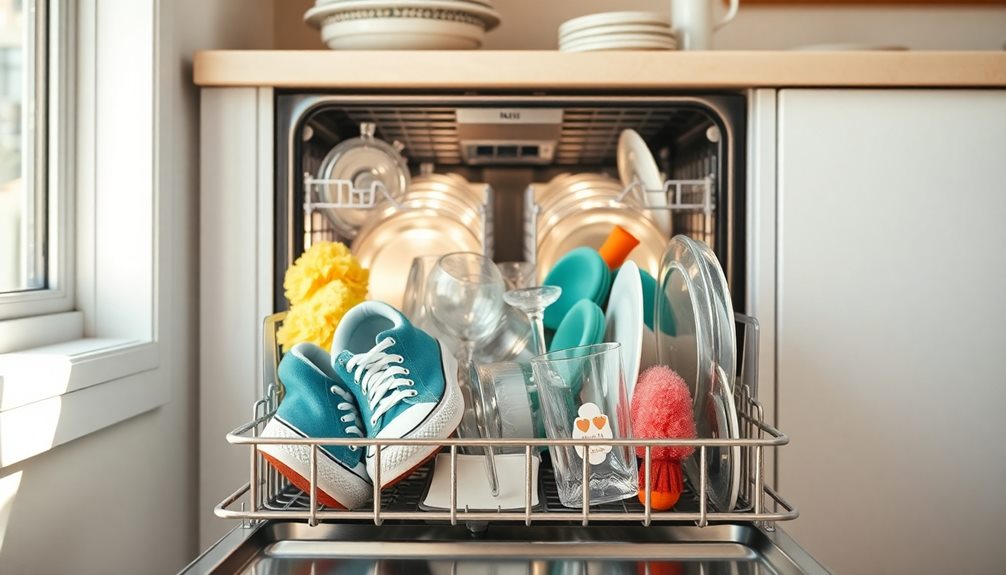
You might not realize how many genius dishwasher hacks can streamline your dishwashing process. Start by organizing your dishes in the sink, and wash the cleanest items first to avoid grease transfer. Invest in essential tools, like a stainless steel sink caddy and a double-sided silverware cleaning brush. Maintain hygiene by regularly sanitizing your sponges and brushes. Don't forget to hand wash delicate items like sharp knives and crystal. Use higher fat content butters for nonstick cookware to keep them in great shape. There's much more to discover that can enhance your kitchen efficiency!
Key Takeaways
- Organize dishes in the sink before washing to streamline the dishwashing process and reduce clutter.
- Use Dawn foaming soap for more powerful cleaning, effectively tackling tough grease and grime.
- Regularly clean and sanitize sponges and dish brushes to prevent bacteria buildup and cross-contamination.
- Hand wash delicate items like crystal and wooden utensils to ensure they remain undamaged.
- Utilize vertical storage solutions for cookware to minimize scratches and enhance kitchen organization.
Efficient Dishwashing Preparation
To make your dishwashing routine more efficient, start by organizing your dishes before you even turn on the water. Stack your plates and bowls neatly in the sink to keep everything in order. This efficient dishwashing preparation is key to speeding up the process.
Begin by washing the cleanest items first—like glasses and cups—before tackling the more challenging pots and pans. This method minimizes grease transfer and cross-contamination, keeping your dishes cleaner.
While cooking, clean as you go. This not only reduces the buildup of dirty dishes but also makes your post-cooking cleanup a breeze. Additionally, sort your silverware into a cup to keep it together; it makes washing easier and more efficient.
Gather all necessary tools—like sponges, brushes, and dish soap—before diving into the washing process. Using the right tools guarantees a smoother and more organized experience.
Essential Dishwashing Tools

Having the right tools can make all the difference in your dishwashing routine. One essential dishwashing tool is a stainless steel sink caddy. It helps you organize your brushes and sponges while being made from rust-proof material, guaranteeing durability.
To tackle tough grease and grime, opt for Dawn foaming soap; it's five times more powerful than regular liquid soap, making it a game-changer for your cleaning efforts.
Another handy tool is a double-sided silverware cleaning brush. This tool simplifies the cleaning process, allowing you to effectively reach both sides of your utensils for a thorough wash.
To make sure your dishwashing tools remain effective, it's vital to regularly clean and sanitize them. This practice helps prevent cross-contamination and maintains hygiene.
Lastly, consider a glass refillable foam dispenser. It not only adds a touch of aesthetic appeal to your sink area but also promotes cost-effectiveness by reducing waste from disposable soap containers.
Maintaining Hygiene Standards

Maintaining hygiene standards in your dishwashing routine is vital for preventing the spread of bacteria. Start by regularly cleaning your sponges and dish brushes. Sponges can trap moisture and harbor bacteria, while dish brushes are less likely to do so.
To keep your dish brushes disinfected, soak them in distilled white vinegar for 1-2 hours. This effective method helps prevent cross-contamination during your hand washing. Additionally, confirming that your pets are safe from toxic substances like certain flowers can also contribute to a healthier home environment.
When it comes to drying your dishes, air drying is the way to go. It's more sanitary than using kitchen towels, which can transfer bacteria back onto your clean items.
Don't forget to maintain your sink's hygiene, too. Utilize a specialized sink cleaning brush to minimize bacterial spread to your dishes.
Consistently sanitizing your dishwashing tools is essential. Keep them organized in a stainless steel sink caddy for easy access and to further reduce the risk of cross-contamination.
Caring for Special Cookware

While keeping your kitchen tools hygienic is important, caring for special cookware is just as vital to preserve their quality and longevity. You want to make sure that your beloved items last, so take the time to clean them right away and avoid the dishwasher.
Additionally, ensuring your cookware is free from bacteria and contaminants can help promote overall health, much like maintaining good dental hygiene is essential for preventing oral health issues.
Here are some tips to help you care for your special cookware:
- Always hand wash sharp knives to maintain their sharpness and avoid dulling the blades.
- For cast iron skillets, clean them immediately while they're warm and skip the soap to keep the seasoning intact.
- Crystal and wooden utensils require gentle hand washing to prevent deterioration over time.
Don't forget about insulated tumblers like BruMate mugs; those should also be hand washed to prevent damage from the dishwasher's heat and pressure. If you see a "hand wash only" label, take it seriously and treat those items with care.
Nonstick Cookware Tips

When it comes to nonstick cookware, using the right cleaning techniques is essential to keep it in top shape.
You should also consider how you store your pans, as improper stacking can lead to scratches that ruin the nonstick surface.
Let's explore some safe cleaning methods and proper storage tips to extend the life of your favorite cookware.
Safe Cleaning Techniques
Safety is paramount in the kitchen, especially when it comes to cleaning nonstick cookware. Using the right techniques not only guarantees your safety but can also save you money by prolonging the life of your pans.
Here are some essential tips: Consider using higher fat content butters as they can enhance your cooking process while also being gentle on your nonstick surfaces. Avoid nonstick cookware treated with Teflon and PTFE chemicals.
Clean pots and pans immediately after use to prevent stubborn residue. Use oils with high smoke points, like avocado oil, to protect your cookware.
When dealing with burnt food, don't panic! Simply boil water in the pan, add two tablespoons of baking soda, and let it work its magic to loosen stubborn residue.
Opting for high-quality alternatives like GreenPan can further enhance your cooking experience while maintaining safety.
Proper Storage Methods
To keep your nonstick cookware in top shape, proper storage methods are crucial.
Begin by avoiding the temptation to stack pots and pans directly on top of each other. Instead, use soft materials like towels or cloths between them. This simple job cleaning can prevent scratches, which degrade the nonstick coating over time.
Consider investing in dedicated storage solutions such as pot racks or cabinet organizers. These can help keep your cookware accessible while minimizing wear and tear. If you must stack your nonstick pans, always place a cloth or paper towel between them. This extra layer of protection will help maintain their nonstick properties and extend their lifespan.
Organizing your cookware is key. Arrange them in a way that prevents contact between surfaces, which greatly reduces the risk of damage.
Remember, the better you store your nonstick cookware, the longer it will last and perform effectively. By taking these precautions, you'll guarantee your nonstick pieces remain in excellent condition, making your cooking experience that much more enjoyable.
It's all about creating a storage environment that prioritizes the longevity of your beloved cookware.
Smart Cookware Storage Solutions

When it comes to storing your cookware, using vertical storage techniques can save space and keep everything accessible.
You can also protect your pots and pans with padding to prevent scratches and damage.
These smart solutions not only organize your kitchen but help extend the life of your essentials.
Vertical Storage Techniques
Maximizing space in your kitchen can elevate both functionality and organization. By adopting vertical storage techniques for your cookware, you can save much time and effort while keeping your kitchen neat. Here are some smart ideas to get you started:
- Use pan racks or wall-mounted shelves to store pots and pans, preventing scratches and damage to nonstick coatings.
- Install cabinet organizers or pull-out shelves for easy access to frequently used items, eliminating the need to dig through clutter.
- Leverage magnetic strips or hooks to hang lids vertically, creating more space and keeping everything within reach.
These solutions not only enhance your kitchen's organization but also prolong the lifespan of your cookware. Instead of stacking pots and pans—which can degrade their protective coatings—use dividers or towels between each piece.
Additionally, dedicated storage options like tiered racks for baking sheets and cutting boards help keep everything tidy. With these vertical storage techniques, you'll find it much easier to locate and retrieve your cooking essentials, making your kitchen experience smoother and more enjoyable.
Protective Padding Methods
Over time, improper storage can lead to scratches and damage to your cookware, which is why using protective padding methods is essential. Start by investing in towels or pan racks when stacking your pots and pans. Stacking without protection can degrade coatings over time, making your cookware less prone to wear.
Consider using felt or silicone liners between stacked items to create a protective barrier. This helps maintain the integrity of nonstick surfaces and other delicate finishes, ensuring they stay in top shape.
Additionally, storing your cookware vertically in dedicated storage solutions minimizes contact, which can prevent scratches and prolong the lifespan of your kitchen tools.
Organizing your cookware by size and type not only reduces clutter but also allows for easier access, minimizing the risk of damaging surfaces during retrieval. Properly spacing your cookware in cabinets can help avoid chipping and scratches, ensuring that each piece remains in good condition for longer.
Frequently Asked Questions
How Can I Prevent My Dishes From Sticking Together in the Dishwasher?
To prevent your dishes from sticking together in the dishwasher, make sure you load them properly, allowing enough space between items. You can also try using a rinse aid to help reduce moisture and sticking.
What Is the Best Way to Load Glasses to Avoid Breakage?
To avoid breaking glasses in the dishwasher, you're better off placing them on the top rack, ensuring they're secured between tines. Don't let them touch each other, and avoid overloading the dishwasher.
Can I Wash Plastic Containers in the Dishwasher Safely?
Yes, you can wash plastic containers in the dishwasher safely. Just make sure they're labeled as dishwasher-safe, and place them on the top rack to avoid warping from the heat of the bottom.
How Do I Remove Odors From My Dishwasher?
To tackle odors, you could think your dishwasher's just dirty, but it might be food residue or mold. Try running it empty with vinegar or baking soda; it'll freshen things up and eliminate lingering smells effectively.
Is It Safe to Run the Dishwasher While I'm Not Home?
Yes, it's generally safe to run your dishwasher while you're not home. Just make sure it's in good condition, and avoid overloading it. Always check for leaks or issues before leaving. Stay worry-free!
Conclusion
By embracing these genius dishwasher hacks, you'll not only streamline your dishwashing routine but also extend the life of your cookware. Did you know that nearly 70% of households use their dishwashers inefficiently, wasting both time and energy? With the right tools and techniques, you can save money and resources while keeping your kitchen spick and span. So, start implementing these tips today, and you'll wonder how you ever lived without them!
Claire is our in-house smart home guru. With a visionary background in electrical engineering and a professional history dotted with stints at leading tech companies, Claire has an unparalleled understanding of smart home technology. She has a talent for demystifying complex concepts, making them accessible to everyone, from tech novices to enthusiasts. Whether it’s the latest in home automation or the newest intelligent kitchen gadget, Claire’s insights help you confidently navigate the smart home landscape.
-

 Expert2 months ago
Expert2 months agoTop 15 Luxury Kitchen Appliance Brands Reviewed
-

 Vetted2 months ago
Vetted2 months ago8 Best Condensing Tumble Dryers for Efficient Drying Performance
-

 Expert2 months ago
Expert2 months agoWhich Appliances Are Made in Canada
-

 Expert2 months ago
Expert2 months agoWhere Is Smeg Appliances Made
-

 Vetted2 months ago
Vetted2 months ago15 Best Brand Refrigerator Water Filters to Keep Your Water Clean and Fresh
-

 Vetted2 months ago
Vetted2 months ago15 Best Fruit and Vegetable Washing Machines for Cleaner, Safer Produce
-

 Expert2 months ago
Expert2 months agoHow Many Appliances Can a 1 Inch Gas Line Supply
-

 Vetted2 months ago
Vetted2 months ago15 Best Halogen Ovens for Quick and Efficient Cooking







